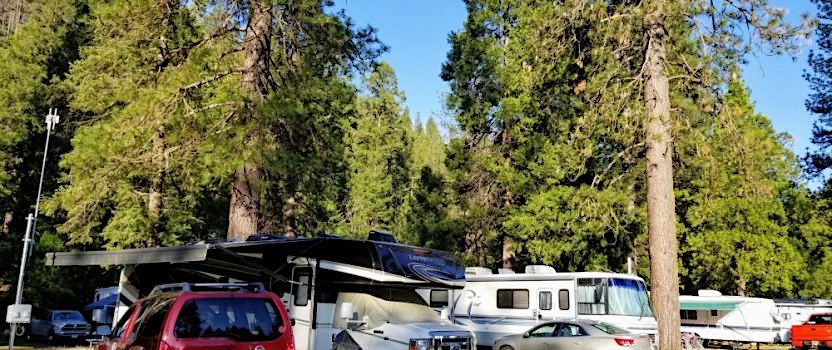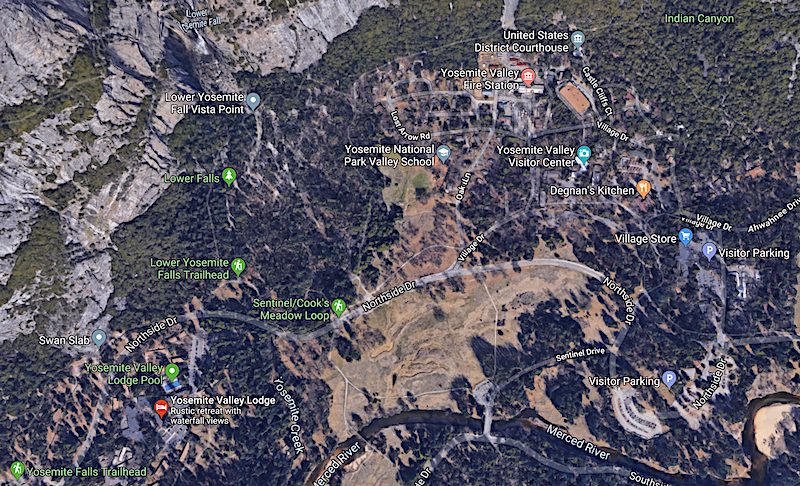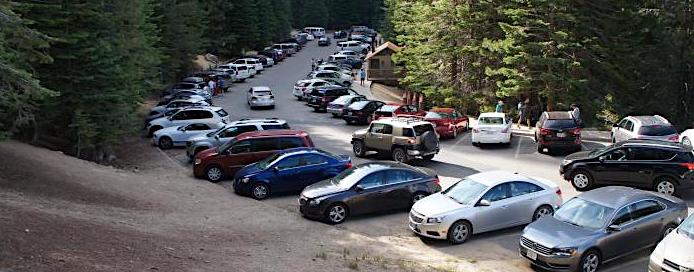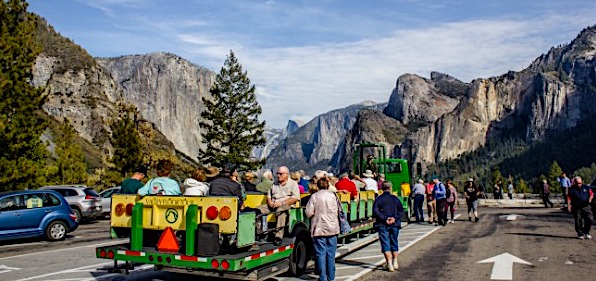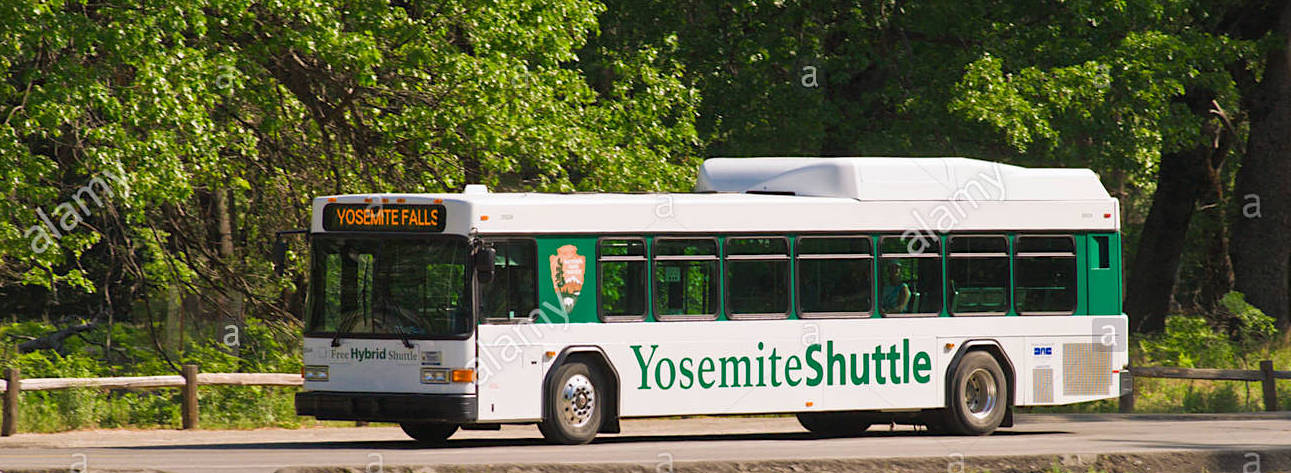Thanks for your support! If you make a purchase using our links in this article, we may make a commission. And, as an Amazon Associate, I earn from qualifying purchases. See the full disclosure here.
Parking an RV can be a challenge. Parking an RV in a National Park filled with crowds can be downright intimidating! No one wants to spend valuable time in a National Park searching for a parking spot or worrying about someone towing your vehicle.
Our complete guide to RV parking in Yosemite will give you peace of mind as you prepare to explore this national treasure. We’ll go over where to park and areas where you should not park. We’ll cover the best spots for scenic photos as well as road restrictions for larger vehicles.
RV Parking in Yosemite
RV Parking in Yosemite doesn’t have to be stressful. There are ways to beat the crowds if you plan ahead. If possible, plan to visit the park during the spring or fall instead of the summer. Weekdays are usually much less crowded than weekends. Avoid visiting on holidays if at all possible. Click here to learn the visiting hours and seasons for Yosemite.
A good rule for visiting any National Park is to plan your visit around the mid-day rush. Over four million people visit Yosemite each year. Arriving early to the park will be well worth it as parking will be open and easier to access.
Likewise, arriving at the park later in the day (after 4 p.m. is best) allows you to take advantage of the flood of folks leaving the park and scoop up their parking spots.
The list below includes the primary parking lots throughout the park. While some of the smaller lots and overlooks may not be included, you can find these by using your park map. Keep in mind that smaller lots are more likely to be filled due to their size. Therefore, planning your trip and parking around these larger lots will provide the best results.
RV Parking in the Yosemite Valley Area
Located in the south-central area of the park, the Yosemite Valley is most easily accessed from highways 120 (west entrance) and 140. If you are arriving from the east entrance of the park, it could take several hours to reach the Valley, so be sure to allow enough time for travel.
The Yosemite Valley is by far the most popular area of the park. To park with ease, definitely, plan to get to the Valley early or late in the day. If you arrive after 9:00 a.m. you will have great difficulty getting a parking space until later in the day.
The main road in the Valley is the Yosemite Valley Loop. Most of this loop is one way, so if you miss a turn to a particular stop or overlook, you will have to circle the entire valley. This could take anywhere from 30 minutes early in the day to several hours, depending on traffic.
During the day, you can park RVs and travel trailers in a few key locations throughout the valley. Once parked, you can use the Yosemite Valley shuttle to get to all of the points of interest in the valley. For detailed maps of Yosemite click here.
RV Parking at Half Dome Village
The best parking for larger RVs and trailers is located at the Half Dome Village Day Use parking lot. This large lot is located near the Pines campgrounds and has many parking spaces. It is tucked away just past Yosemite Village so spaces may be available there once the Yosemite Village lot is full.
From this parking lot, you can access the trails near Vernal and Nevada Falls, the Happy Isles Trail and Nature Center, the Mirror Lake Trail and more. You can also hop on the in-park shuttle which will take you anywhere in the valley.
RV Parking at Yosemite Village
Located near the Yosemite Village and Visitor Center, this parking lot is the most popular and the first to fill up each day. Smaller Class C RVs can easily park in this lot. There are some spaces for larger RVs as well. Keep in mind that since this parking lot is the most popular, it usually fills up by 9 a.m.
From this lot, you can access the Visitor Center, Yosemite Village, shops and restaurants. You can also walk to Yosemite Falls and the Valley Loop. The shuttle stops at this location frequently and will give you access to anywhere in the valley.
RV Parking Near Yosemite Falls
The parking lot near Yosemite Falls is at the very end of the valley loop, meaning that it is usually the last to fill. If you are having difficulty finding spots elsewhere in the valley, this area is the best place to look for spaces.
From this lot, you can access Yosemite Falls, walk to Yosemite Village, Sentinel Beach, and the Swinging Bridge. You can also hop on the shuttle that will take you throughout the valley.
RV Parking in the Tuolumne Meadows Area
Tuolumne Meadows is open from late May or June until November. If you decide to visit this area, plan to arrive by 10 a.m. to have a chance at finding parking. Along Tioga Road, there are many turnouts for taking photos and admiring the view. Once you have found parking, you can explore the area by utilizing the Tuolumne Meadows shuttle.
Tuolumne Meadows Campground and Store Parking
This area offers limited 30-minute parking. While it can be convenient for a quick stop or trip to the Visitor Center, it is not recommended for daily use.
Lembert Dome Parking and Picnic Area
This is the largest parking area in Tuolumne and is the best place to try to find a spot. From this area, you can access several hiking trails including the Soda Springs and Lembert Dome Trails. You can also hop on the Tuolumne Meadows shuttle bus to check out other points of interest in the area.
Dog Lake RV Parking
There is a small parking lot at Dog Lake. This lot is only recommended for smaller RVs and is not suitable for travel trailers. You can also get to this area by using the Tuolumne Meadows shuttle. From Dog Lake, you can access the Dog Lake Trail, Lyell Canyon, and the John Muir Trail.
RV Parking Near Tenaya Lake
Tenaya Lake is a beautiful area for swimming, sunbathing and picnicking. The lake has two small parking lots, one at either end of the lake, plus parking along the shoulders of Tioga Road, which runs along the lake.
RV Parking in the Wawona Area
The Wawona area of Yosemite is a great starting point for exploration of the sequoias and the history of Yosemite. Wawona has a gas station that is open year-round along with a campground, dump station (open seasonally during the summer), hotel, restaurant, visitor center and points of interest such as the Pioneer Yosemite History Center.
Mariposa Grove
The Mariposa Grove is the largest sequoia grove in Yosemite and is a must-see while you are at the park. The only parking available at the grove is for folks with a valid disability-parking placard. Everyone else will need to park at the Mariposa Grove Welcome Plaza and take the shuttle to the grove. This lot has about 300 spaces and usually fills by late morning.
Wawona Store and Visitor Center Parking
The largest parking area in Wawona is in the area around the Wawona Store and Visitor Center. From here you can visit the Pioneer Yosemite History Center and Hill’s Studio. You can also get a meal at the Wawona Hotel.
Parking at Glacier Point
The views from Glacier Point are picture perfect and well worth the hour long drive to the top. Glacier Point Road is open seasonally and even in late spring can close with short notice due to late season snow.
During the shoulder seasons (spring and fall) you can drive to the Glacier Point parking area, although the maximum vehicle length is 30 feet. During the summer months, there is a shuttle from Badger Pass Ski Area to Glacier Point. There is ample parking in this area, including spots for RVs.
Hetch Hetchy Area Parking
Hetch Hetchy is a quieter area of Yosemite filled with hiking trails, waterfalls, and wildflowers. Parking is available in the main lot, which is 38 miles from the Yosemite Valley.
From this lot, you can access the O’Shaughnessy Dam, the Wapama Falls Trail, Smith Peak, and Poopenaut Trails. The Hetch Hetchy area is the only part of the park that is not open 24 hours a day, so be sure to check road closing times before heading to that area of the park.
Can I Park My RV Overnight in Yosemite?
There is absolutely NO overnight RV parking in Yosemite. Park rangers strictly enforce this, and there are no exceptions. You must have a campsite to stay overnight. Campsites throughout the park book up months in advance and there are limited first-come, first-serve sites in the park. None of the campgrounds in the park have hookups.
Because the campgrounds and RV rentals in and near Yosemite are usually booked months in advance, it is not wise to plan to visit Yosemite and stay overnight without making arrangements at a private campground or having a reservation within the park.
RV Parking at Scenic Overlooks
Yosemite National Park features many fantastic scenic overlooks. The park service has done a great job creating pullouts at many of these overlooks to provide a safe place to stop and take in the view or snap a photo. Remember only to use these designated areas to stop as pulling off on the side of the road can be extremely dangerous and is not allowed.
Even a small RV takes up a lot of space in the limited parking that is typically found in overlooks, so be mindful of when you stop and try to keep your visit short. Watch out for people, especially children, that will frequently be entering and exiting their vehicles at these locations. Be sure to pull off the road entirely and follow all posted guidelines.
The best way to plan ahead for the overlooks and pullouts is to utilize the paper park map provided when you enter the park.
Can I Pull My RV Over and Park to Take Photos?
The beautiful scenery of Yosemite inspires awe and can easily distract even the most careful driver. Keep your eyes on the road to ensure safety for you and your family. If you want to take a picture, you need to pull over. Keep in mind that you should not pull over just anywhere.
Roads in Yosemite are often steep, curvy mountain roads that are not suitable for stopping or pulling over. Shoulders can be steep or unstable and should not be utilized unless it is an emergency. Do not veer off the road to take photos, as it can be unsafe for you and those following you.
To take photos, always utilize pullouts. Once you are safely parked, you will be able to take your time and enjoy the view. Respect other visitors and do not block traffic. Ignoring these rules can lead to injury or even death.
RV Parking Rules and Road Restrictions in Yosemite
For your safety, the park has rules and restrictions for driving and parking. Rangers enforce these rules and failure to follow the rules could lead to your dismissal from the park.
It is important to follow posted speed limits and stay alert as the park is crowded nearly every day, and pedestrians are frequently crossing the roads at many locations.
Remember to always utilize pullouts for stopping and do not create new parking spots by pulling off of the road in any area. Violators may be towed and/or cited.
Road Restrictions for RVs
While most roads in Yosemite are suitable for RVs and travel trailers, it is important to know that the roads are winding, mountain roads. Inexperienced RVers may be overwhelmed by the challenge of driving these steep roads with lots of traffic.
Remember always to follow the speed limit and drive slow and safe. If you notice cars following you, use one of the many turnouts to allow them to pass. Patience and deep breaths will get you up (and down) the mountains.
There are some areas of the park that do have restrictions for RVs and trailers. Be sure to read through this information carefully to avoid a dangerous situation.
Wawona Road (Hwy 41)
The maximum vehicle length on Wawona Road is 45 feet. At the Wawona Tunnel, there is a height restriction of 10 feet 2 inches at the curb.
El Portal Road (Hwy 140)
The maximum vehicle length on El Portal Road is 45 feet per vehicle, 60 feet for combination vehicle and 35 feet for towed vehicle. There is also a height restriction of 12 feet 10 inches.
Big Oak Flat Road (Hwy 120 from the West)
The maximum vehicle length on Big Oak Flat Road is 45 feet. There is also a height restriction of 10 feet 3 inches.
Tioga Road (Hwy 120 from the East)
This road is closed from approximately November through May or later. Pulling a vehicle over the Tioga Pass is challenging and should not be attempted by inexperienced RVers. The best way to avoid this is to enter Yosemite from the west, not the east.
For those attempting the Tioga Pass, make sure you follow the towing capacity of your vehicle. This grade is simply too steep to risk going beyond your vehicle’s recommended capacity.
Make sure to check your braking system before attempting the drive. Keep in mind that you most likely will not be able to keep up with other traffic. Use pullouts and take your time.
Have a plan for a breakdown. It may take hours for you to be reached, so make sure you are prepared in the event of an emergency.
Glacier Point Road
The maximum vehicle length for the end of Glacier Point Road (past Sentinel Dome/Taft Point) is 30 feet. No trailers are allowed. This road is closed from approximately November through May.
During the summer months, no vehicles are allowed at Glacier Point. Instead, you can park at the Badger Pass Ski Area and take the shuttle to the top. RV parking is available at Badger Pass.
Mariposa Grove Road
The maximum vehicle length for Mariposa Grove Road is 25 feet. No trailers are permitted on this road. To access the grove, you can park in the parking area and use the free shuttle.
Hetch Hetchy Road
The maximum vehicle length on Hetch Hetchy Road is 25 feet. Maximum vehicle width is 8 feet from mirror to mirror. This is the only road in the park that is not open 24 hours a day. Be sure to check the hours that the road is open each day as they vary seasonally.
Other Options to Avoid RV Parking
If you are traveling by RV and do not wish to drive throughout the park, there are other options available.
The Yosemite Area Regional Transportation System (YARTS) operates a bus service from areas outside of the park to popular destinations in the park. Once you are in the park, you can take the Yosemite shuttles to get to where you would like to go.
YARTS is a great option for RVers who do not want the hassle of parking their RV in Yosemite. You can also bring your bikes on the bus! Tickets range from $8-30 depending on your starting location and destination. Park admission is included with your ticket.
Conclusion
No matter how you travel, Yosemite is a destination not to be missed. With some patience and planning, you can have a wonderful, stress-free RV experience in in the park.
For more awesome articles about how to visit Yosemite and our other national Parks check out our other informative articles below!
- Best RV Camping In and Near Yosemite
- RV Camping in Humboldt Redwoods State Park
- The Complete Guide to RV Parking in Yellowstone
- The Best RV Camping In (and Near) Yellowstone
- Do Drivetime Calculators Really Work?
- Why Are RV Park Rates So High?
- 6 Best RV Parks Near Kanab Utah
- The 8 Best RV Campgrounds in Colorado
- The Complete Guide to RV Parking in San Francisco
- 21 Must-Have RV Accessories for a New Camper or Travel Trailer
- The 5 Best RV Campground Memberships
Do you have any tips or suggestions for RV Parking in Yosemite National Park? Please leave your comment below. Your contribution may help a fellow RVer!

